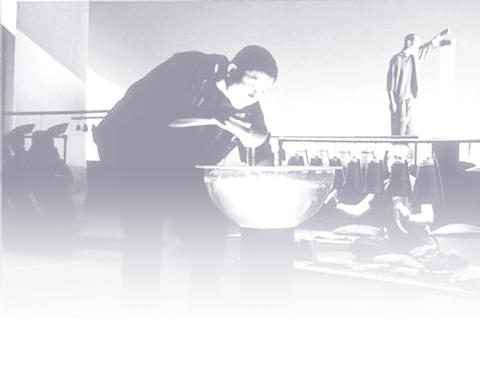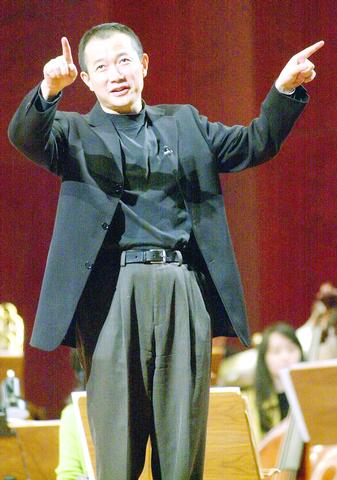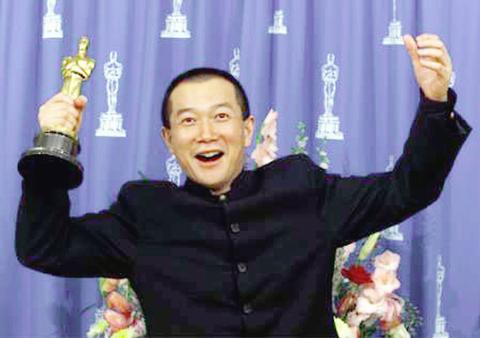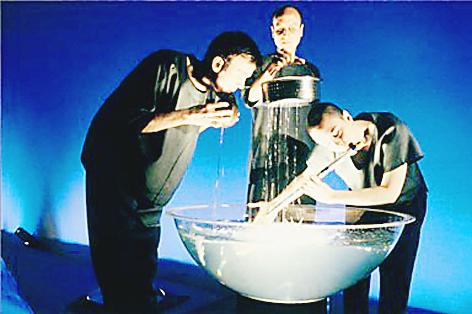The question most beg to ask composer Tan Dun (譚盾) since he captured an Oscar for best original score in Crouching Tiger, Hidden Dragon(臥虎藏龍) is how his life was changed by winning the award.
"Not at all," is the answer he gave in an interview with Taipei Times.

"I'm still focusing on my writings and operas, which are always my main pursuit. The Crouching Tiger soundtrack for me was a side dish," Tan said, speaking via telephone from New York.

PHOTO: TANG CHUNG-YIN, TAIPEI TIMES
Though he may sound underwhelmed by his Oscar now, he was clearly swept up in the excitement of receiving the award at the ceremony in March. Backstage at the Shrine Auditorium in Los Angeles, hoisting his golden statuette, he ecstatically claimed the prize was an honor for Chinese people around the world.
"Of course I was happy. But the recognition of the Oscar honor is less important to me as an individual artist. It is more important for [Chinese] culture," he said.

PHOTO COURTESY OF MANDELA (PR & MARKETING)
"Being recognized and honored by the Academy [of Motion Picture Arts and Sciences] is a very good thing for the culture, especially for an artist who grew up in Asian culture. It hopefully marks a turning point where all the existing barriers and boundaries can be broken and different cultures can communicate with each other," he said.

PHOTO COURTESY OF MANDELA (PR & MARKETING)
Tan is certainly qualified to speak of cultural interchange. Having moved from the Beijing Central Conservatory to Columbia University, the Hunan born 44 year-old, has made a career of blending cultures, musical instruments and artistic forms.
His 1997 work Symphony 1997 -- Heaven, Earth, Mankind incorporated Chinese bells from the Imperial Bell Ensemble, cello by Yo-yo Ma (馬友友) and the Hong Kong Philharmonic, creating an imposing synthesis of musical styles.
Tan's most recent Taiwan appearance in December was with The Gate (門), a part of his Orchestral Theater series. In that piece, he combined Peking opera, Western opera and Japanese traditional puppet theater. The work put on the same stage Yu-ji (虞姬), a character from the Peking opera Farewell My Concubine, Juliet from Shakespeare's Romeo and Juliet and a classic Japanese puppet character Koharusen, and even included video art projections for a sweeping, multimedia-tinged opera.
Then, in the Crouching Tiger soundtrack, Tan called on Yo-yo Ma again, this time to use his trademark cello to recreate the sliding tones of the Chinese Erhu (二胡).
"When I was composing the music, I told Yo-yo Ma that the reason I appreciate the cello is not that it can be used to play the music of Bach or Dvorjak. But rather because the instrument has a transcendent quality that makes it more than just a Western musical instrument. It can create sounds that most closely relate to the feelings I wanted to express," said Tan.
Since the Oscars, Tan has made a new composition titled Crouching Tiger Hidden Dragon Concerto, a six-movement concerto loosely based on music from the film that will premiere in Taipei next month and will then be taken to St Petersburg and Washington, DC. After that, Tan's schedule is booked until 2006 with projects including an opera commissioned by the New York Metropolitan Opera.
"Right now I'm working on how to present the concerto's Taiwan premiere. I will combine the music with video art and a new type of music called water percussion. So the audience in Taiwan will get to hear something completely new," Tan said.
Percussionist David Cossin, who was also part of The Gate, will create and play the water percussion segments. "There will be splashing sounds, pouring and dripping sounds. These will be nicely arranged and added to the concerto music of Crouching Tiger Hidden Dragon," Tan said.
Tan also said the video projections to be used in the piece were filmed by director Ang Lee (李安).
"Ang [Lee] has edited a new version of the film, which contains the best images in the movie, cut with street scenes from New York and Beijing. The production will transmit a post-modern feeling of transcending time and space and culture," he said.
Despite is grand themes and cultural montage, Tan insists his art is more than a mere hodgepodge. "In the end, it's not about high culture and low culture, it's not about East and West," he said. "For an artist, it's about the latitude of freedom an artist has to make his own creations. Only when I have the least limitations am I able to find my own artistic language, my own appreciation of the world."
Tan Dun and Crouching Tiger Hidden Dragon -- A Multimedia Concert will be held in Taipei on May 18th, 7:30pm at the Taipei International Convention Center. Tickets available from Era Ticketing. Tel: (02) 2325-5311.

May 26 to June 1 When the Qing Dynasty first took control over many parts of Taiwan in 1684, it roughly continued the Kingdom of Tungning’s administrative borders (see below), setting up one prefecture and three counties. The actual area of control covered today’s Chiayi, Tainan and Kaohsiung. The administrative center was in Taiwan Prefecture, in today’s Tainan. But as Han settlement expanded and due to rebellions and other international incidents, the administrative units became more complex. By the time Taiwan became a province of the Qing in 1887, there were three prefectures, eleven counties, three subprefectures and one directly-administered prefecture, with

Taiwan Power Co (Taipower, 台電) and the New Taipei City Government in May last year agreed to allow the activation of a spent fuel storage facility for the Jinshan Nuclear Power Plant in Shihmen District (石門). The deal ended eleven years of legal wrangling. According to the Taipower announcement, the city government engaged in repeated delays, failing to approve water and soil conservation plans. Taipower said at the time that plans for another dry storage facility for the Guosheng Nuclear Power Plant in New Taipei City’s Wanli District (萬里) remained stuck in legal limbo. Later that year an agreement was reached

What does the Taiwan People’s Party (TPP) in the Huang Kuo-chang (黃國昌) era stand for? What sets it apart from their allies, the Chinese Nationalist Party (KMT)? With some shifts in tone and emphasis, the KMT’s stances have not changed significantly since the late 2000s and the era of former president Ma Ying-jeou (馬英九). The Democratic Progressive Party’s (DPP) current platform formed in the mid-2010s under the guidance of Tsai Ing-wen (蔡英文), and current President William Lai (賴清德) campaigned on continuity. Though their ideological stances may be a bit stale, they have the advantage of being broadly understood by the voters.

In a high-rise office building in Taipei’s government district, the primary agency for maintaining links to Thailand’s 108 Yunnan villages — which are home to a population of around 200,000 descendants of the Chinese Nationalist Party (KMT) armies stranded in Thailand following the Chinese Civil War — is the Overseas Community Affairs Council (OCAC). Established in China in 1926, the OCAC was born of a mandate to support Chinese education, culture and economic development in far flung Chinese diaspora communities, which, especially in southeast Asia, had underwritten the military insurgencies against the Qing Dynasty that led to the founding of